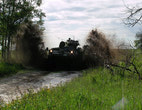E COY LdSH(RC) PUTS THE LAV TUA TO THE TEST
By Capt Mike Pattle
June 2006
The Light Armoured Vehicle TOW Under Armour (LAV TUA) is the first element of the Direct Fire Unit (DFU) to begin Initial Product Testing (IPT). LdSH(RC) will eventually receive 18 of the CF’s latest and greatest vehicle, and, as the end user, they were given the task to support the Reliability, Availability, Maintainability, and Durability (RAMD) testing conducted at CFB Wainwright.
Echo Company (E Coy) began this endeavour by sending the senior NCOs and Officers to London, ON for Initial Cadre Training (ICT) from 5 – 13 Mar 06. ICT was designed to convert the leadership of E Coy and the Infantry School subject matter experts on the operator (gunner, crew commander and driver) differences between the M113 TUA and the LAV TUA. Once the core knowledge was gained, they returned to Edmonton to begin work on lesson plans for a conversion course that would convert the remainder of the company. Immediately following ICT for the operators, the ICT for the maintainers was conducted, predominantly delivered to pers from the NATO Maintenance and Supply Agency (NAMSA) and Canadian Forces Support Training Group (CFSTG). These personnel were then responsible for the delivery of the conversion training to the maintenance personnel from HQ Sqn LdSH(RC), 3 ASG, and CFB Wainwright.
E Coy received the initial four LAV TUAs in mid-April and it was the drivers who were the first from the company to get some hands on training; receiving instruction on the differences between the LAV III APC and the LAV TUA (which were few). Next, they spent some time getting familiar with the different driving characteristics of the new vehicle by taking it through the driving circuit at CFB Edmonton. A whopping 14 feet from the top of the turret, this is one big vehicle; however, the drivers easily adapted to the different centre of gravity, as the turret is located further to the rear and off to one side.
The conversion training began the last week of April and ran until the second week of May. The NCOs were now responsible to pass on the knowledge that they had learned in London to the soldiers who would eventually be in Wainwright supporting the trails. At the end of six days of training, the soldiers could safely and effectively operate the weapon system.
The RAMD testing kicked off on 15 May and will run until 7 Jul 06. The LAV TUA RAMD is designed with emphasis on monitoring TUA weapon, surveillance and command and control component integration and functionality. Running 24/5, the vehicles were put to the test under a variety of conditions, including highway and cross-country driving, silent watch, and of course live fire ranges.
The soldiers were anxious to begin the testing and to get the opportunity to familiarize themselves with their new piece of kit. They quickly established their routines, as some had to make the adjustment of working the graveyard shift from 2400 – 0800hrs. The crews worked exceptionally well with the RAMD Testing Staff who monitored closely and systematically the processing of technical incident reports (TIRs), as well as fault indication, corrective action and failure analysis.
The Improved Target Acquisition System (ITAS) and the Fire Control System (FCS) are the main improvements to the new turret. The improvements include: 2 X detection range, 2 X zoom (2nd generation Forward Looking Infrared (FLIR)), and aided target tracker.
The integration of a proven chassis and a state of the art turret have made the LAV TUA arguably one of the most lethal machines on the modern battlefield. Whether the LAV TUA is conducting surveillance or bringing precision fire to bear, it will offer commanders unsurpassed flexibility in the Contemporary Operating Environment (COE) and providing everything goes according Hoyle during the RAMD testing, we could see this awesome war fighting machine overseas as early as TF 2-07.






